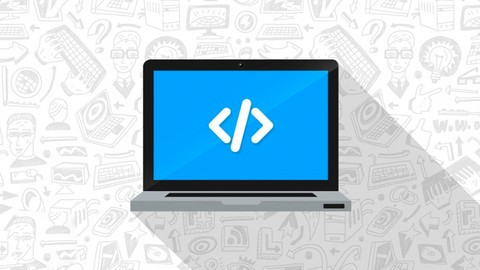
Beginners Guide to Learning Programming
Beginners Guide to Learning Programming, available at $49.99, has an average rating of 4.1, with 45 lectures, based on 91 reviews, and has 537 subscribers.
You will learn about Do You Find Programming Confusing? Learn The Key Fundamentals That Make Programming In Any Language Simple This course is ideal for individuals who are Any One Who Wants To Learn How To Program or No Prior Programming Skills Needed – A Course For Complete Novices It is particularly useful for Any One Who Wants To Learn How To Program or No Prior Programming Skills Needed – A Course For Complete Novices.
Enroll now: Beginners Guide to Learning Programming
Summary
Title: Beginners Guide to Learning Programming
Price: $49.99
Average Rating: 4.1
Number of Lectures: 45
Number of Published Lectures: 44
Number of Curriculum Items: 45
Number of Published Curriculum Objects: 44
Original Price: $39.99
Quality Status: approved
Status: Live
What You Will Learn
- Do You Find Programming Confusing?
- Learn The Key Fundamentals That Make Programming In Any Language Simple
Who Should Attend
- Any One Who Wants To Learn How To Program
- No Prior Programming Skills Needed – A Course For Complete Novices
Target Audiences
- Any One Who Wants To Learn How To Program
- No Prior Programming Skills Needed – A Course For Complete Novices
Want To Learn How To Program? This Course Will Teach You The Core Principles Of Programming In Any Computer Language – Quickly And Easily.
This Learning Programming training course from Infinite Skills teaches you everything you need to know to start programming. This course is designed for the absolute beginner, meaning no programming or coding experience is required.
You will start by learning programming terms, such as statements, variables, parameters, and operators. From there, this course will teach you programming concepts, including how to create a solution, assign and change variable values, and perform mathematical calculations. This video tutorial will also cover abstract programming concepts, such as procedural and functional programming, pseudocode, and flowcharting. This course includes a project that allows you to demonstrate some of the topics that have been discussed throughout the course.
Once you have completed this computer based training course, you will have learned the programming basics. Working files are included, allowing you to follow along with the author throughout the lessons.
Course Curriculum
Chapter 1: Getting Started
Lecture 1: Important – Download These First – Working Files
Lecture 2: Welcome And Overview
Lecture 3: External Computer Architecture
Lecture 4: Internal Computer Architecture
Lecture 5: Defining A Program
Lecture 6: Integrated Development Environments
Lecture 7: Interpreted Versus Compiled Programming Languages
Lecture 8: How To Access Your Working Files
Chapter 2: Programming Terms
Lecture 1: Application And Solution
Lecture 2: Syntax And Syntax Errors
Lecture 3: Statements
Lecture 4: Comments
Lecture 5: Logical And Physical Memory Address
Lecture 6: Object Type
Lecture 7: Variables
Lecture 8: Parameters
Lecture 9: Functions, Procedures And Methods
Lecture 10: Naming Convention
Lecture 11: Operators
Lecture 12: Class
Lecture 13: Accessors And Mutators
Lecture 14: Exceptions
Lecture 15: Runtime Error
Lecture 16: Debug
Lecture 17: Logic And Algorithms
Chapter 3: Programming Concepts
Lecture 1: Creating A Solution
Lecture 2: Building Your Solution
Lecture 3: Starting And Running A Solution
Lecture 4: Deploying Your Solution
Lecture 5: Assigning Or Changing Variable Values
Lecture 6: Performing Mathematical Calculations
Lecture 7: Error Handling Exceptions And Trapping Handling
Lecture 8: Getting Input And Producing Output
Lecture 9: Logical Statements With Operators And Variables
Lecture 10: Decision Structures
Lecture 11: Loops
Chapter 4: Abstract Programming Concepts
Lecture 1: Procedural Programming
Lecture 2: Functional Programming
Lecture 3: Object-Oriented Programming And Design Patterns
Lecture 4: Pseudocode
Lecture 5: Flowcharting
Lecture 6: Object Modelling With UML Structure
Lecture 7: Data Structures
Chapter 5: Conclusion
Lecture 1: Conclusion And Next Steps
Instructors
-
Infinite Skills
High Quality Training
Rating Distribution
- 1 stars: 3 votes
- 2 stars: 5 votes
- 3 stars: 19 votes
- 4 stars: 30 votes
- 5 stars: 34 votes
Frequently Asked Questions
How long do I have access to the course materials?
You can view and review the lecture materials indefinitely, like an on-demand channel.
Can I take my courses with me wherever I go?
Definitely! If you have an internet connection, courses on Udemy are available on any device at any time. If you don’t have an internet connection, some instructors also let their students download course lectures. That’s up to the instructor though, so make sure you get on their good side!
You may also like
- Top 10 Language Learning Courses to Learn in November 2024
- Top 10 Video Editing Courses to Learn in November 2024
- Top 10 Music Production Courses to Learn in November 2024
- Top 10 Animation Courses to Learn in November 2024
- Top 10 Digital Illustration Courses to Learn in November 2024
- Top 10 Renewable Energy Courses to Learn in November 2024
- Top 10 Sustainable Living Courses to Learn in November 2024
- Top 10 Ethical AI Courses to Learn in November 2024
- Top 10 Cybersecurity Fundamentals Courses to Learn in November 2024
- Top 10 Smart Home Technology Courses to Learn in November 2024
- Top 10 Holistic Health Courses to Learn in November 2024
- Top 10 Nutrition And Diet Planning Courses to Learn in November 2024
- Top 10 Yoga Instruction Courses to Learn in November 2024
- Top 10 Stress Management Courses to Learn in November 2024
- Top 10 Mindfulness Meditation Courses to Learn in November 2024
- Top 10 Life Coaching Courses to Learn in November 2024
- Top 10 Career Development Courses to Learn in November 2024
- Top 10 Relationship Building Courses to Learn in November 2024
- Top 10 Parenting Skills Courses to Learn in November 2024
- Top 10 Home Improvement Courses to Learn in November 2024






















